Imagine having a personal assistant at your fingertips, available 24/7 to answer your questions and complete tasks. That’s the power of an AI chatbot.
AI chatbots are becoming increasingly prevalent in our daily lives. These intelligent tools are revolutionizing how we interact with technology. But how do you get the most out of them? To maximize the benefits of AI chatbots, it’s essential to understand how to interact with them effectively.
So, we have made things easy for you. This guide will teach you to talk to an AI chatbot and ask anything online. Let’s dive in and start learning!
What is an AI Chatbot?
An AI chatbot is a computer program that simulates human conversation through text or voice interactions. It uses artificial intelligence (AI) to understand and respond to user queries naturally and intuitively.
AI chatbots rely on two key technologies:
- Natural Language Processing (NLP): NLP enables AI chatbots to understand and interpret human language. It involves breaking down sentences into words and phrases, analyzing their meaning, and identifying the intent behind the user’s query.
- Machine Learning: Machine learning algorithms allow AI chatbots to learn from past interactions and improve their responses over time. The algorithms can identify patterns and predict future user inputs by analyzing large amounts of data.
Using NLP and machine learning, AI chatbots can provide informative and helpful responses to various questions and requests.
Types of AI Chatbots
AI chatbots come in various types, each with unique capabilities and limitations.
1. Rule-Based Chatbots
Rule-based chatbots follow a predefined set of rules and responses. They are relatively simple to create and maintain but have more limitations.
These AI chatbots can only respond to specific queries and cannot understand context or adapt to new information.

2. AI-Powered Chatbots
AI-powered chatbots, on the other hand, leverage advanced technologies like machine learning and natural language processing. These chatbots can understand and respond to complex queries and prompts in a more human-like way, making them more reliable and versatile.
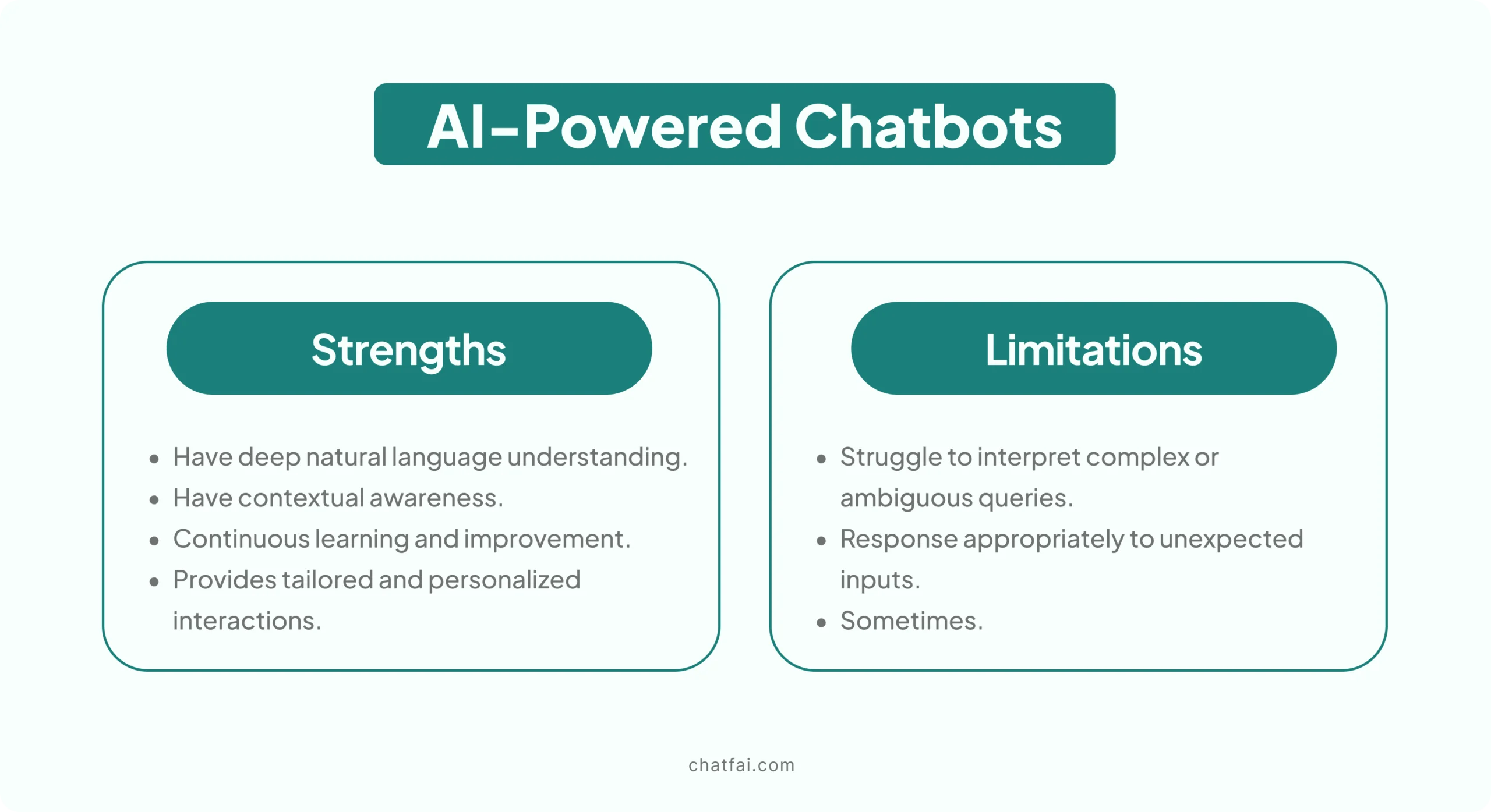
What Can AI Chatbots Do?
AI chatbots can perform tasks in mere seconds that would take human hours, if not days, to complete. Look at what AI chatbots can do to make your life easier and more productive.
- Provide Factual Summaries: AI chatbots can access and process vast amounts of information to provide concise and informative summaries of factual topics.
- Provide Customer Support Service: Businesses use AI chatbots to provide 24/7 customer support, answering common questions and resolving issues.
- Engage in Games: AI chatbots can play various games, from simple trivia to complex strategy games.
- Offer Conversational Companionship: They can engage in friendly conversations with you, offering emotional support and companionship.
- Translate Languages: AI chatbots can translate text and speech between different languages, facilitating global communication.
- Assist with Creative Writing: They can help brainstorm ideas, generate creative text formats, and even write full-fledged stories, blogs, or poems.
- Answer Questions Informatively: AI chatbots can comprehensively answer various questions based on vast knowledge bases.
Benefits of Using AI Chatbots
AI chatbots offer numerous benefits to their users. Let’s have a look at some of them:
|
Benefits
|
Explanation
|
| 24/7 Availability |
Always online, ready to assist you. |
| Quick Response Times |
Provide instant responses to your queries. |
| Efficient Information Retrieval |
Swift & accurate access to information. |
| Problem-Solving |
Help you find solutions to any problem. |
| Personalized User-Experiences |
Provides tailored responses to your needs and preferences. |
| Personal Assistance |
Acts as your digital helper to assist with daily tasks and reminders. |
| Education |
Provide vast knowledge and tutoring on a variety of topics. |
| Brainstorming & Content Creation |
Help you generate creative ideas and content calendars. |
Popular AI Chatbots to Consider for Interaction
Here’s a list of free, easily accessible AI chatbots online that offer a range of capabilities. Let’s explore what these tools have to provide for you.
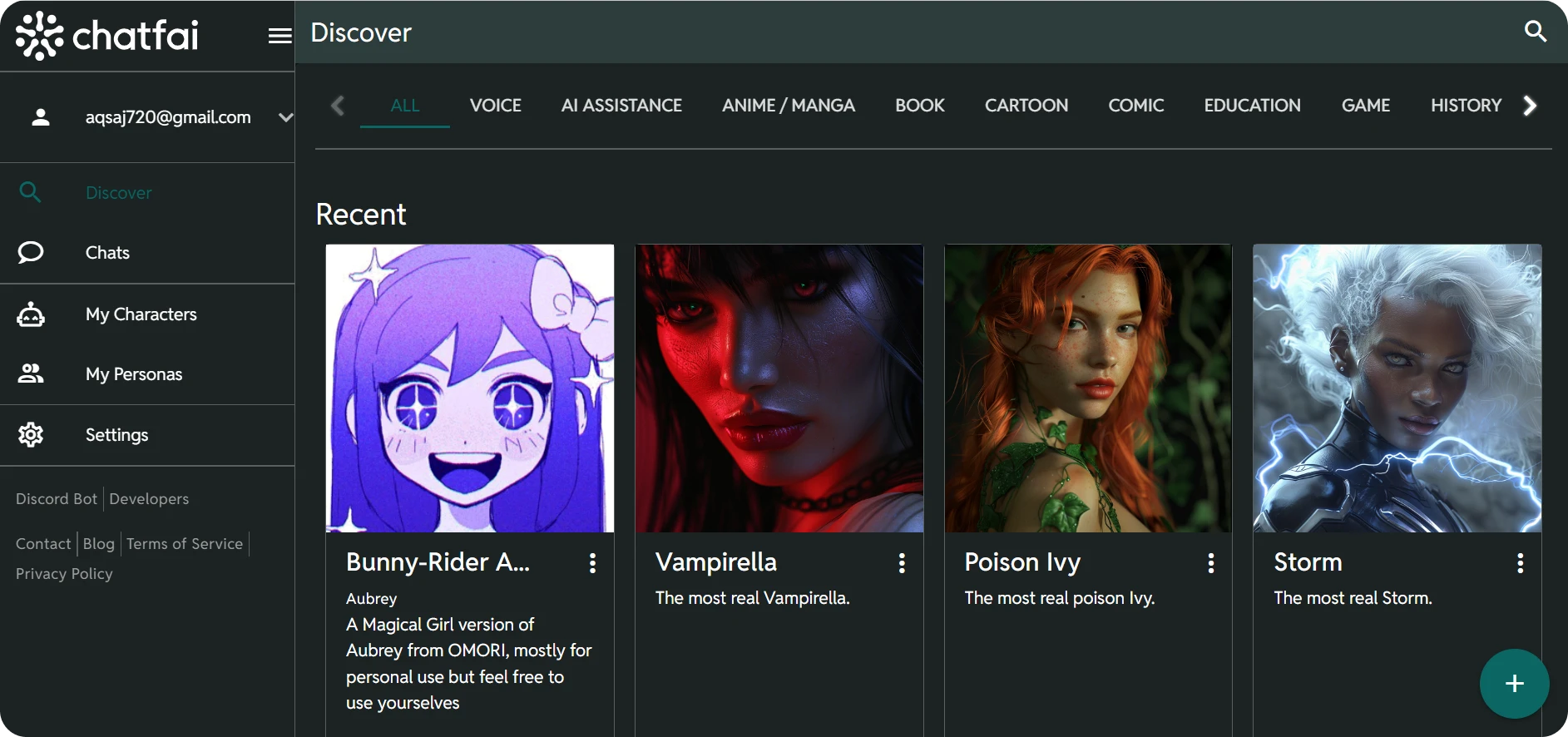
ChatFAI is an advanced language learning model designed to revolutionize the character creation process for writers, game developers, Gen Z, and other creative professionals.
It helps you create customized AI characters easily and engage with them in realistic conversation. You can use ChatFAI to create AI characters/chatbots that can help you with everyday tasks, write content, play games, and design fabulous art for you.
Moreover, with this AI chatbot character generator, you can:
- Create your popular fictional character
- Engage in conversation with it
- And ask anything about its experience in the play/movie/history/drama and more.
You can create movie characters, favorite stars, teachers, essay writers, or AI friends/assistants to have daily conversations with them.
Let’s assume you’re a Potterhead, a die-hard fan of Hermione Granger, and wish to converse with her.
Well, with ChatFAI, you don’t have to assume. In fact, you can create a fictional AI character, Hermione Granger, and talk to her the way you want.
Though the characters generated with ChatFAI are fictional and not real, since they are trained on vast NLP and ML data, you can enjoy a realistic chatting experience.
Here’s a detailed guide about creating and chatting with Harry Potter characters using ChatFAI.
Key Features
Let’s have a look at the key features.
- Diverse Character Generation: Create a wide range of characters, from heroic protagonists to complex villains and AI assistants, each with distinctive physical attributes, personality traits, and backstories.
- Character Customization: Tailor character generation to your specific needs by specifying desired traits, abilities, or thematic elements. You can experiment with different styles, from anime to realistic ones, to bring your characters to life.
- Follow Your Favorite Character: Immerse yourself in the lives of characters you love by following them and their stories and interacting with them in real-time conversation.
- Character Sharing: You can share your creations with the community and collaborate with other users to build rich, dynamic character worlds.
- Chatbot Memory: The created AI chatbot remembers past conversations, allowing more profound and meaningful interactions with your characters. This way, you can experience a sense of continuity and depth in your digital relationships.
- Discord Integration: You can easily integrate your characters into your Discord servers or other social media platforms, add your friends, and bring them to life in your favorite communities.
- Voice Option: Select from various voice options to give your characters a voice. This will add another layer of realism and immersion.
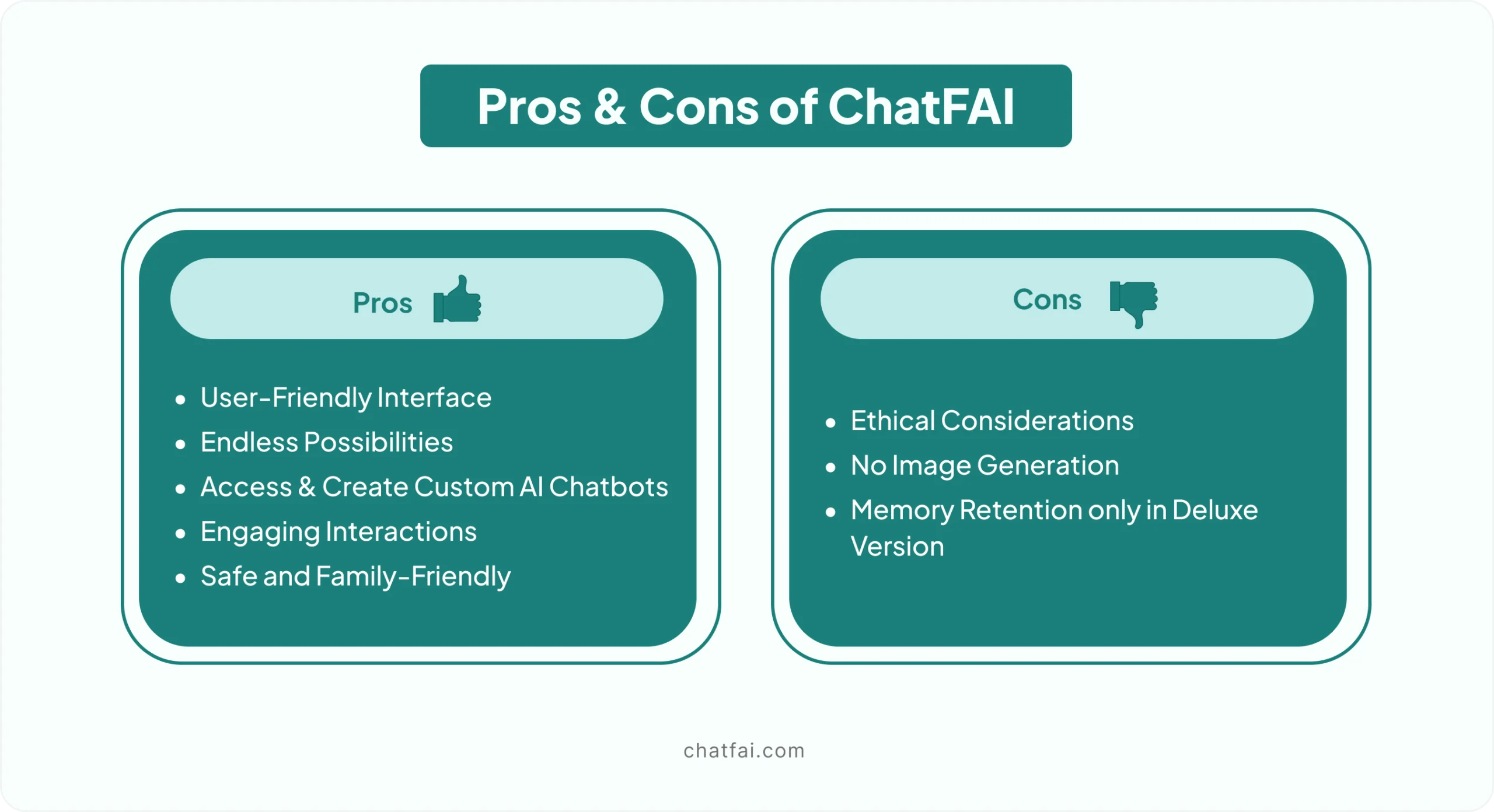
Learn everything about ChatFAI and see how you can use this unique tool creatively.
ChatGPT is a name in the AI world that I bet everybody is familiar with. It is a powerful language model developed by OpenAI. AI ChatGPT can generate human-quality text, translate languages, write creative content, and answer your questions informally.
You can use it as your personal assistant, ask for help with any of your daily tasks, and ask it anything you need help with or have in mind.
In short, this AI chatbot can be your go-to tool for solving all your daily challenges and acting as your online friend, whom you can access anytime.
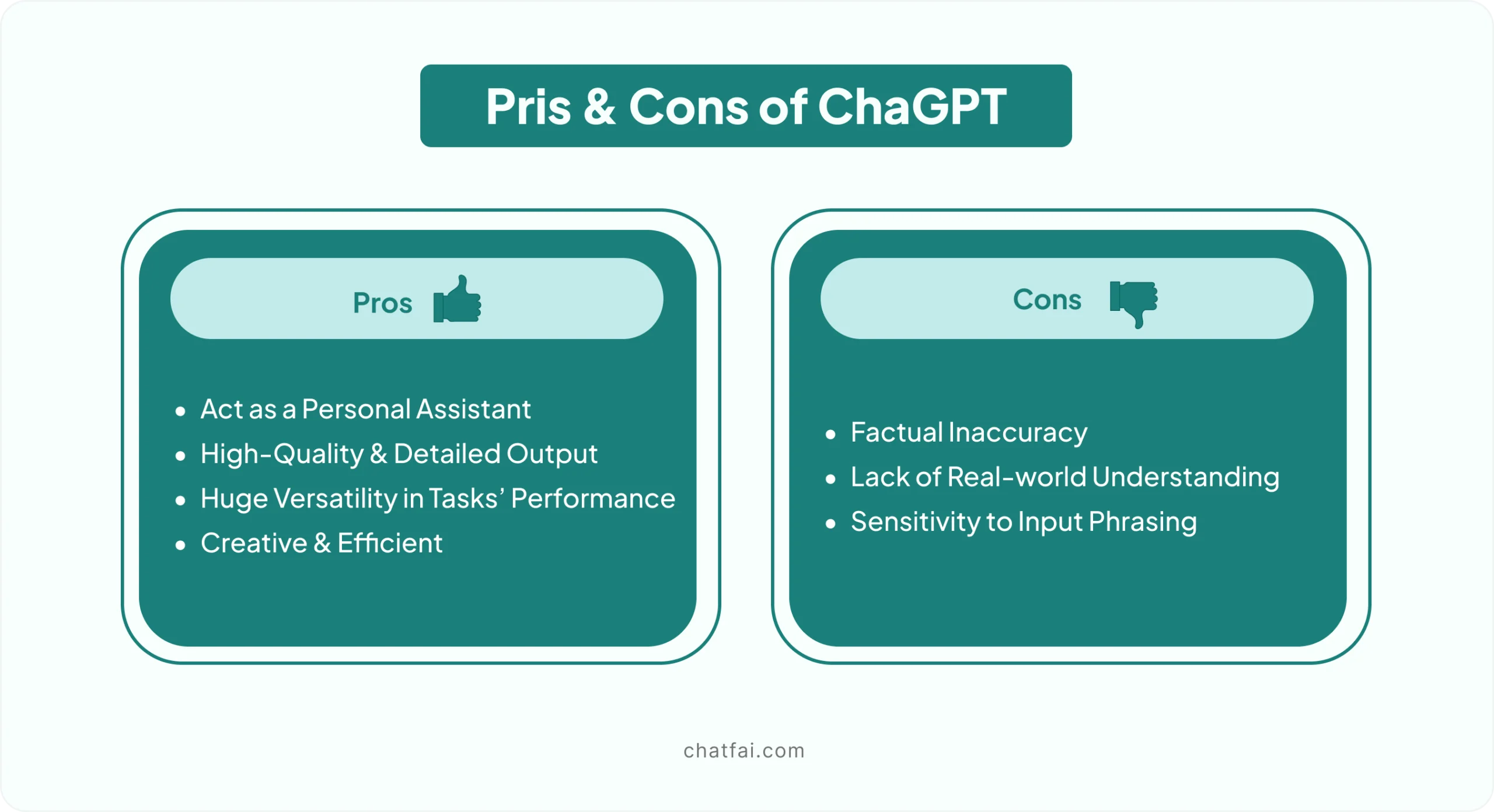
Gemini is an AI chat app developed by Google AI. It’s designed to be a versatile tool capable of understanding and generating code and images.
As a chatbot, Gemini excels at providing detailed and informative responses to various prompts and questions.
A huge plus point of this chatbot that makes it stand out is its ability to access and process information from the real world through Google Search.
You can also generate creative text formats like poems, scripts, musical pieces, emails, and letters.
Get to know the difference between Google Gemini and ChatGPT in this guide.
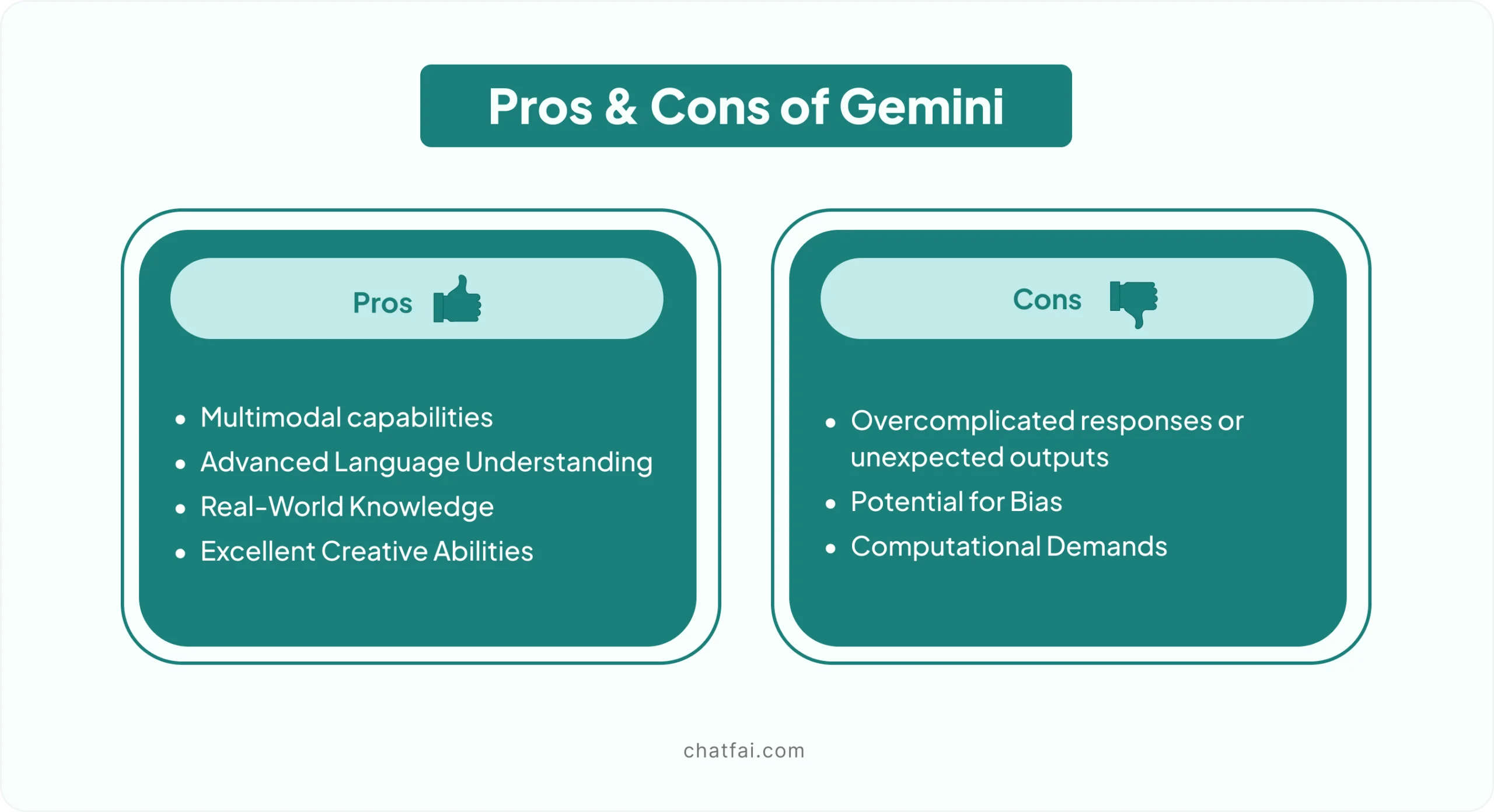
Bing Chat is a powerful AI chatbot integrated into Microsoft’s Bing search engine. It uses the Bing search engine’s vast knowledge and capabilities to provide informative, comprehensive, and engaging responses to your queries.
Bing Chat integrates search results into its responses, providing accurate and up-to-date information.
Moreover, it can generate creative text formats, such as poems, scripts, emails, and more, and provide concise summaries of lengthy articles or complex topics.
It can also translate text between multiple languages as your coding assistant.
Whether you’re seeking factual information, creative writing assistance, or a friendly chat, Bing Chat is ready to assist.
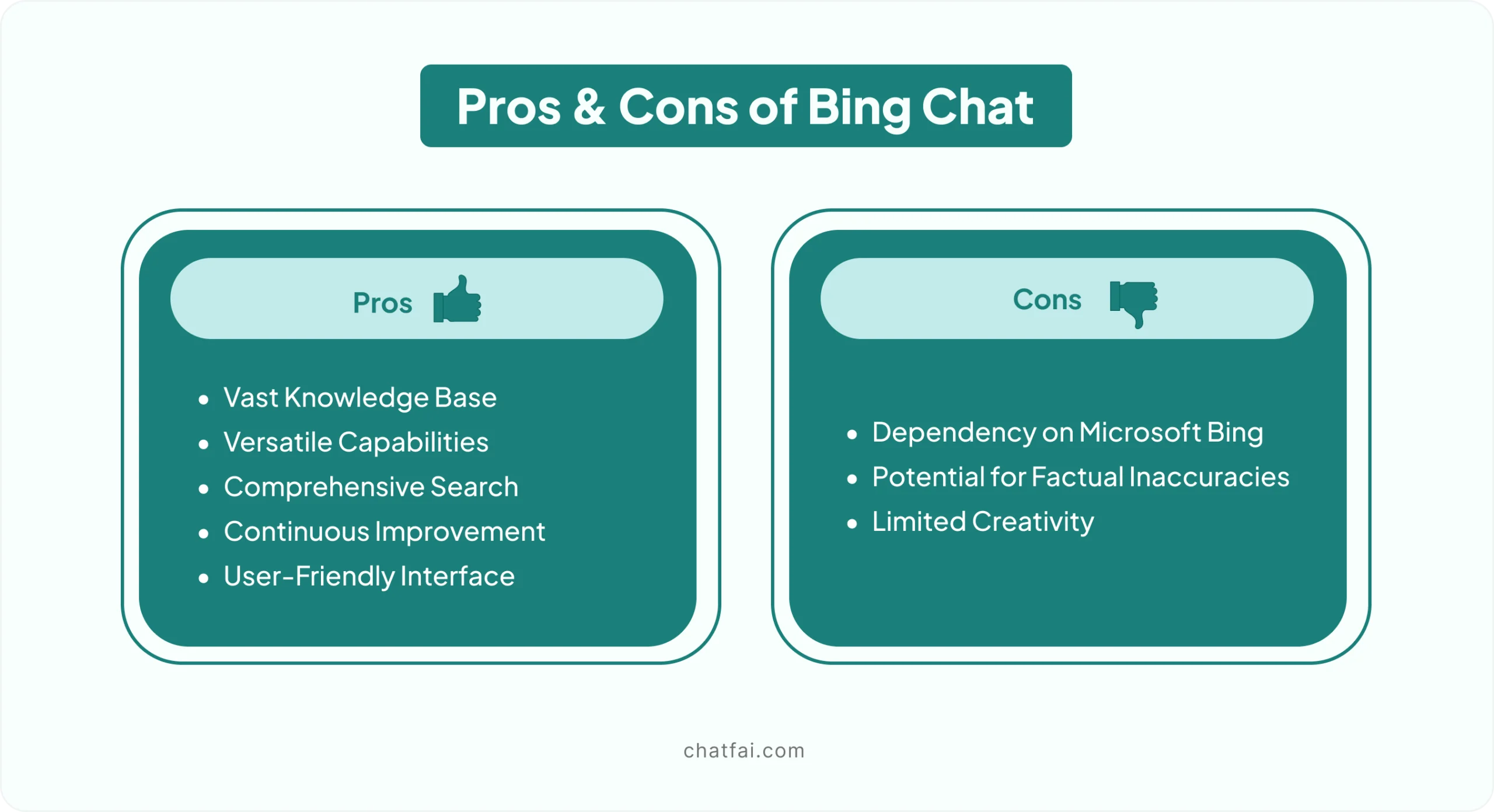
Factors to Consider When Selecting an AI Chatbot
You must consider some factors before selecting an AI chatbot for your assistance.
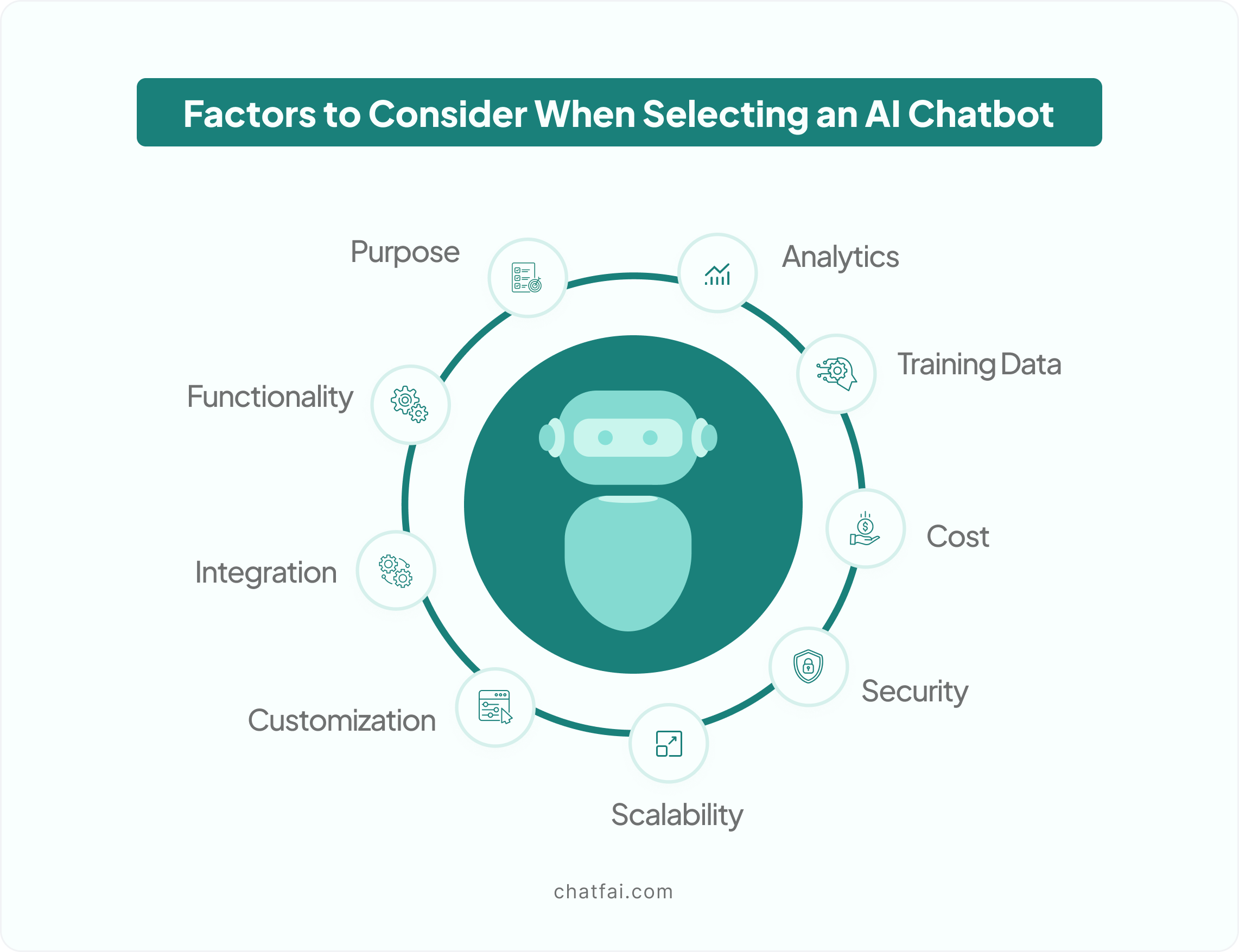
| Purpose |
Clearly define the chatbot’s role (customer service, personal assistant, sales, marketing, etc.). |
| Functionality |
Ensure the chatbot can handle required tasks (answering FAQs, scheduling appointments). |
| Integration |
Verify compatibility with your existing systems (e.g., CRM, website, social media). |
| Customization |
Assess the ability to tailor the chatbot’s appearance, tone, and responses. |
| Scalability |
Consider the chatbot’s capacity to handle increasing workloads and user interactions. |
| Security |
Prioritize data privacy and security measures to protect sensitive information. |
| Cost |
Evaluate the initial setup costs, ongoing maintenance fees, and potential ROI. |
| Training Data |
Determine the amount and quality of training data required for optimal performance. |
| Analytics |
Assess the chatbot’s ability to track user interactions and generate valuable insights. |
How to Talk to an AI Chatbot Effectively
To ask anything from AI chatbots and maximize their potential, consider these strategies:
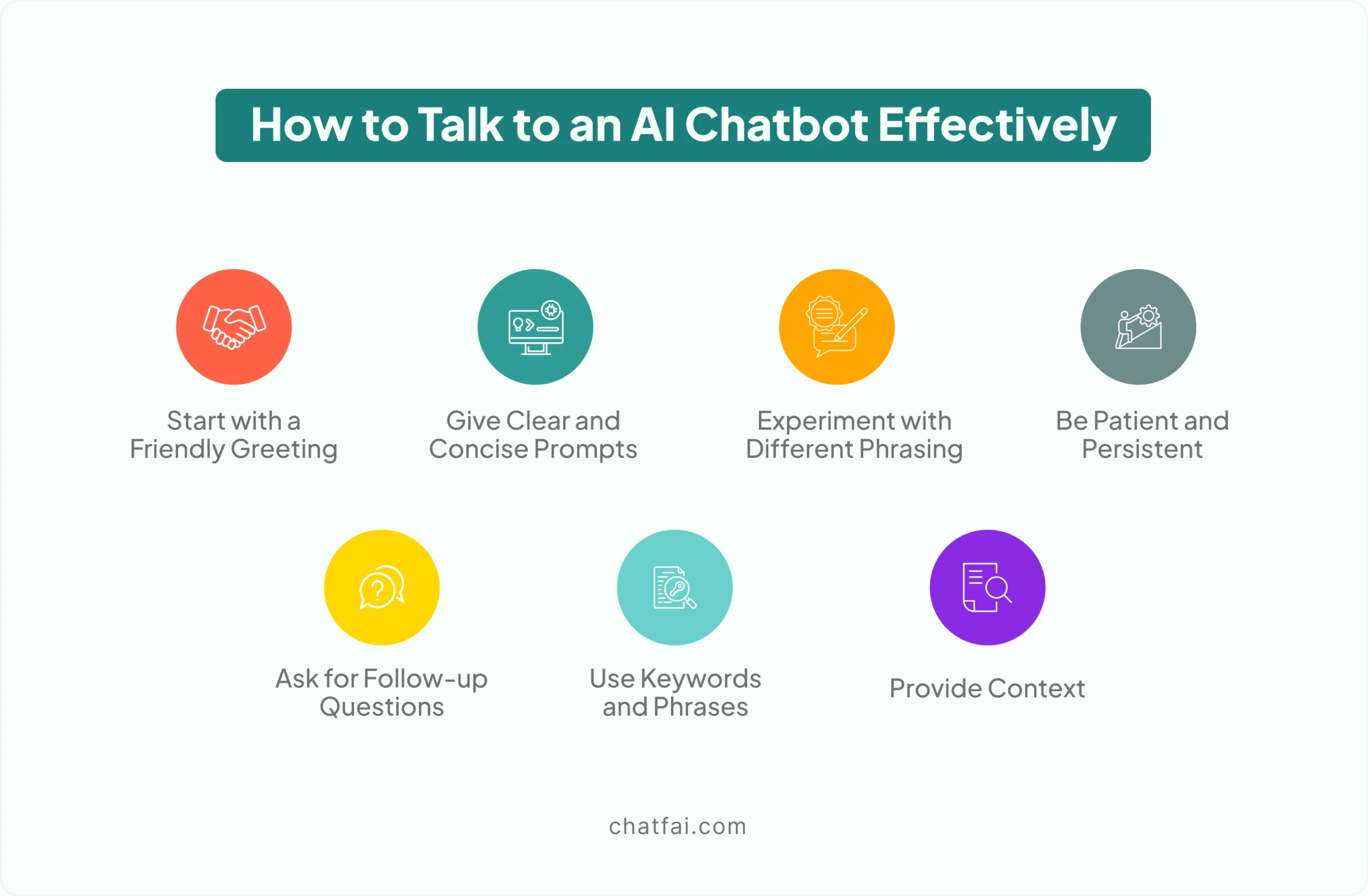
1. Start with a Friendly Greeting
A warm and welcoming greeting sets a positive tone for the conversation. It helps establish rapport and can significantly influence the chatbot’s initial response.
For instance, a simple “Hello, today, I need your help with this (describe your query)?” can make the interaction more personal and engaging.
2. Give Clear and Concise Prompts
Your prompts must be clear and concise when interacting with an AI chatbot. Avoid ambiguity, complex sentences, and jargon. Instead, use simple language similar to speaking to a human.
Because the more human-like and simple your inputs are, the better the chatbot can understand and respond to your requests.
After all, it’s an AI chatbot that works on artificial intelligence, so treat it like that. If you have a complex question, break it into more minor, focused, and specific queries.
For example, instead of asking, “Tell me about AI,” you could ask, “What is artificial intelligence?” “How does machine learning work?” or “How can AI improve customer service?”
Avoid overly technical jargon and complex sentence structures.
Similarly, instead of asking, “Tell me about the French Revolution,” you could ask, “What were the main causes of the French Revolution?” and then, “Who were the key figures involved?”
3. Provide Some Context
Provide context for your query to get an AI chatbot’s most accurate and relevant responses. This helps the chatbot understand your specific needs and goals.
For instance, if you’re asking a question about a particular product or service, provide details such as the brand, model number, or specific issue you’re facing. The more specific your request, the more accurate the chatbot’s response will be.
Instead of asking, “Suggest some skin care products,” ask, “I have oily skin and am currently facing severe acne. I have heard good reviews about this brand’s product (mention name). Could you please break down the ingredients used and suggest whether they are good for acne?”
4. Be Patient and Persistent
AI chatbots are still developing and may not always understand your query on the first try. If you don’t get the desired response, rephrase your question. Moreover, it provides additional context because an AI chatbot requires necessary information about the topic or your query to build an understanding and then reply.
You can also use different words or sentence structures or ask questions differently.
5. Ask for Follow-up Questions
AI chatbots can ask follow-up questions to clarify your query or guide the conversation in a specific direction. Don’t hesitate to answer these questions honestly and completely. This will help the chatbot provide a more accurate and helpful response.
For example, “Can you tell me more about your specific requirements for an AI chatbot?”
6. Use Keywords and Phrases
Using relevant keywords and phrases can help the AI chatbot understand your questions more accurately.
For example, include relevant keywords in your prompt if you’re asking a question about a specific topic. This can help the chatbot identify the most relevant information from its knowledge base.
7. Experiment with Different Phrasing
AI chatbots are constantly learning and improving. By experimenting with different phrasings, you can help the chatbot learn and provide better responses in the future.
Don’t be afraid to try different approaches to get the best results. If you’re unsatisfied with the initial response, try rephrasing your question or providing additional context.
Try asking the same question in different ways to get distinct responses. This can help you gain a deeper understanding of the topic.
For instance, instead of asking, “What is AI?” you could ask, “How does AI work?” or “What are the ethical implications of AI?”
Remember: The more effectively you communicate with an AI chatbot, the more helpful and informative your interactions will be. So, talk to an AI chatbot as if you’re talking to a real-time friend.
These tips can enhance your interactions with AI chatbots and help you get the most out of these powerful tools.
Effective communication is vital whether you use an AI chatbot for customer service, education, or personal assistance.
Limitations of AI Chatbots
While AI chatbots have made our lives easy and possess significant benefits, they still have limitations that can impact their effectiveness.
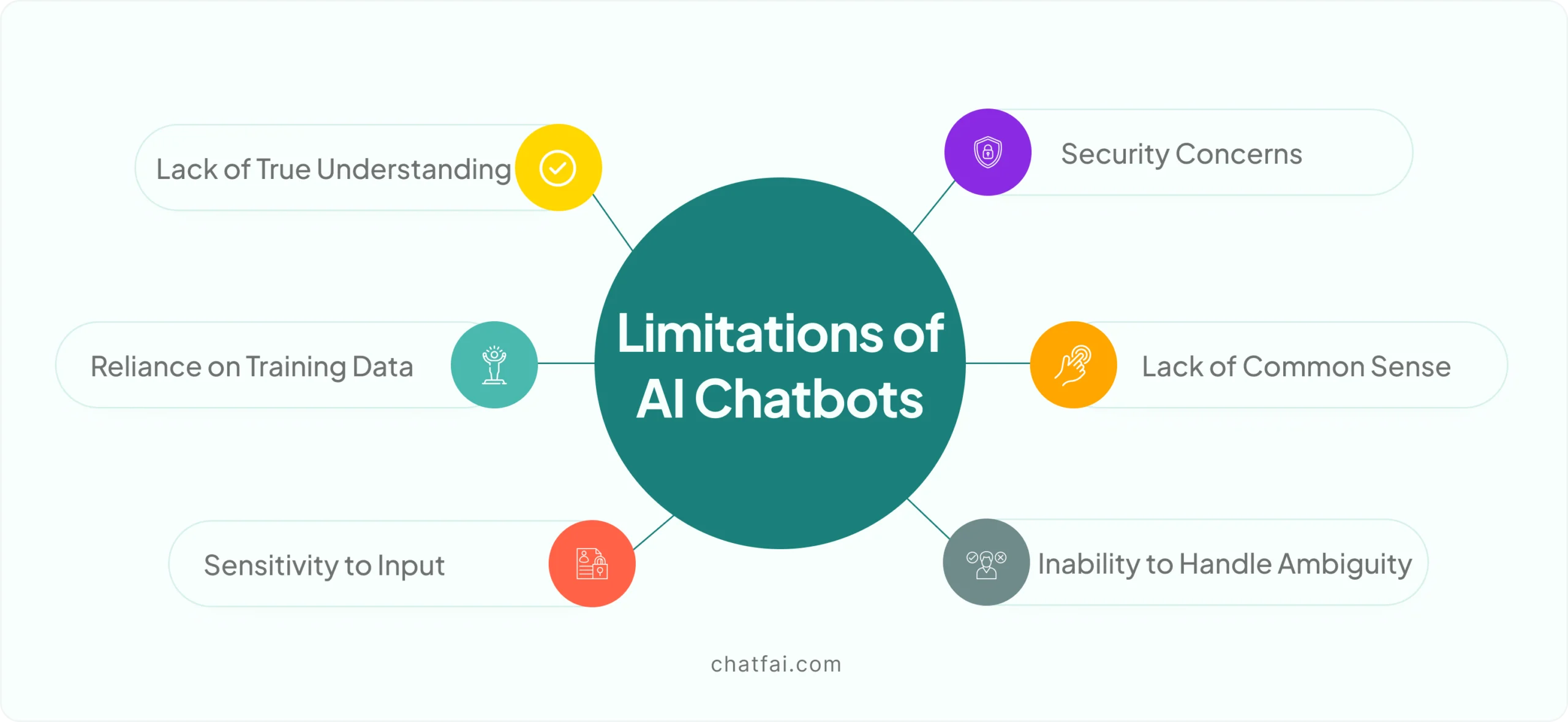
- Lack of True Understanding: Despite advancements in natural language processing, AI chatbots often lack a deep understanding of context, human language, and human emotion.
- They struggle to interpret complex queries, sarcasm, and cultural references or respond appropriately to open-ended questions, which can lead to inaccurate or irrelevant responses.
- Reliance on Training Data: AI chatbots learn from the data on which they are trained. The chatbot’s responses may be inaccurate or insensitive if the training data is biased or incomplete.
- Sensitivity to Input: AI chatbots can be sensitive to the phrasing of questions. A slight change in wording can lead to significantly different responses, sometimes even contradictory ones.
- Inability to Handle Ambiguity: When faced with ambiguous or unclear queries, AI chatbots may struggle to provide accurate and relevant answers. They often rely on predefined responses or generic information.
- Lack of Common Sense and Real-World Knowledge: AI chatbots lack common sense and real-world knowledge. They may generate technically correct responses but are nonsensical or irrelevant in a given context.
- Privacy and Security Concerns: As AI chatbots collect and process user data, privacy and security concerns arise. Implementing robust measures to protect user information from unauthorized access, data breaches, and potential misuse is crucial.
Wrap Up
That is a wrap. We hope this guide has helped you learn how to talk to an AI chatbot and get the most out of this innovative technology. The pro tip is to talk to an AI chatbot conversationally as if you’re talking to a human and provide all the necessary information about your query.
Also, understand AI chatbots’ capabilities and limitations so that you can use their AI power to improve your lives effectively. Be clear, concise, and patient when communicating with your AI chatbot. Ask anything you want and seek help for all your tasks.
So, buckle up and start exploring the world of AI chatbots today! Experiment with different AI chatbot platforms and discover how they can enhance your daily life.
In the comments below, share your experiences and insights on how AI chatbots have changed your daily routine and work efficiency with others.
FAQs
Which is the Best AI Chatbot?
The “best” AI chatbot depends on your specific needs. Popular options include ChatGPT, Bard, and Bing Chat, each with strengths and weaknesses. When choosing, consider factors like accuracy, creativity, and ability to follow instructions.
Is Ask AI Free?
Yes, the Ask AI chatbot is free to use. However, some advanced features or increased usage require a subscription or credits.
What is an AI Chatbot?
An AI chatbot is a computer program that simulates human conversation through text or voice. It uses artificial intelligence to understand and respond to user queries. An AI chatbot can provide information on various topics, complete tasks, or offer assistance.
How to Use ChatGPT?
To use ChatGPT, create an OpenAI account. Then, you can access the chatbot through the web interface or API. Simply type your query or prompt into the chat box, and ChatGPT will generate a response.
Is Siri a Chatbot?
While Siri can engage in conversations and perform tasks, it’s primarily a virtual assistant rather than a chatbot in the traditional sense. It focuses on completing tasks and providing information rather than engaging in open-ended conversations.